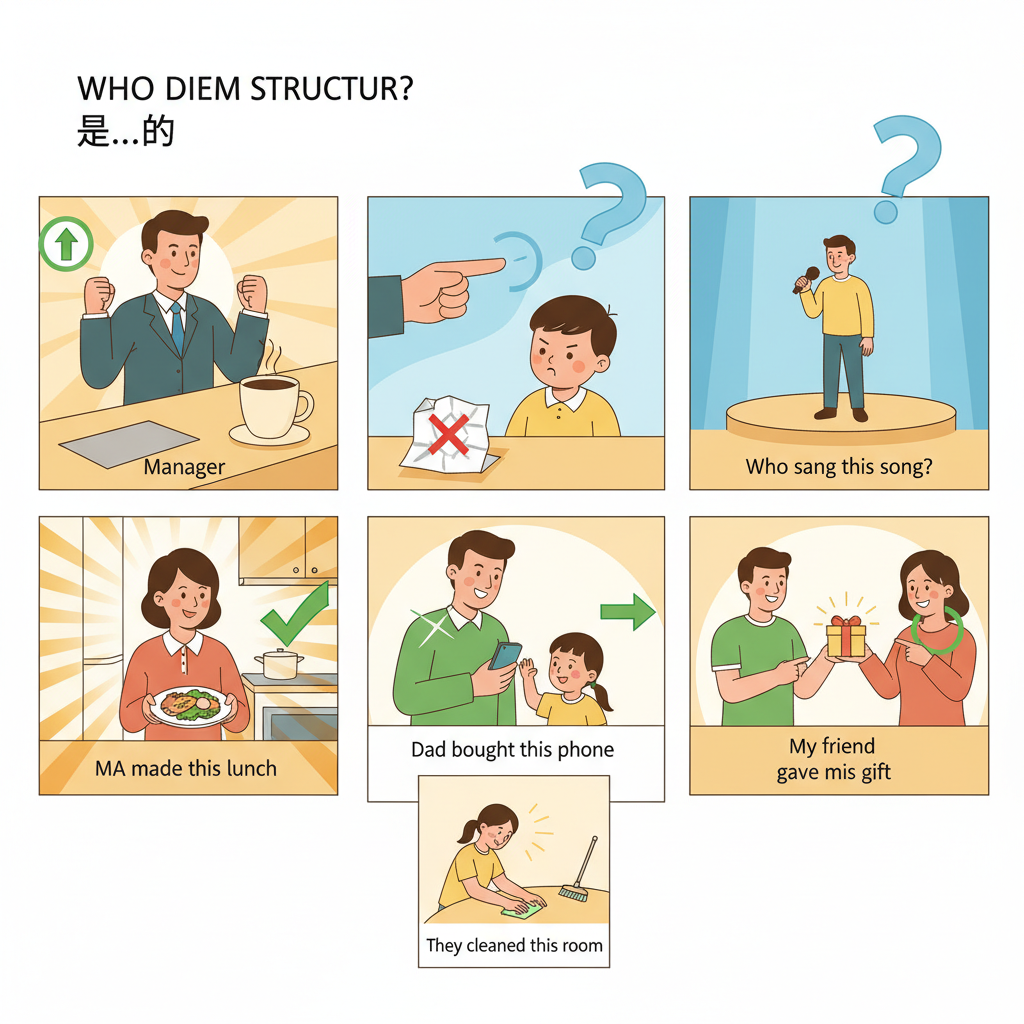🎯 Emphasis Structure 是...的 (shì...de) - Who Did It

🇪🇸 ESPAÑOL
¡Hola! Hoy vamos a estudiar la estructura 是……的 (shì...de). La usamos para enfatizar un detalle concreto de una acción que ya sabemos que ha ocurrido. En la lección de hoy nos centraremos en destacar quién realizó esa acción.
Imagina que llegas a casa y ves la cena preparada. El hecho de que "la cena está hecha" es evidente. Si preguntas quién la cocinó, o si quieres aclarar que fue una persona en concreto, usarás esta estructura. Se forma poniendo el objeto, luego 是 (shì), seguido de la persona (el agente), el verbo y, finalmente, la partícula 的 (de). Para la forma negativa, simplemente usamos 不是 (bú shì).
🇬🇧 ENGLISH
Hello! Today we are going to study the structure 是……的 (shì...de). We use it to emphasize a specific detail of an action that we already know has occurred. In today's lesson we will focus on highlighting who performed that action.
Imagine you arrive home and see dinner prepared. The fact that "dinner is made" is evident. If you ask who cooked it, or if you want to clarify that it was a specific person, you will use this structure. It is formed by putting the object, then 是 (shì), followed by the person (the agent), the verb, and finally the particle 的 (de). For the negative form, we simply use 不是 (bú shì).
📚 Key Phrase: 这杯咖啡是王经理买的。 (Zhè bēi kāfēi shì Wáng jīnglǐ mǎi de.)
Grammar Focus
📝 Grammar Structure | Estructura Gramatical
🇪🇸 ESPAÑOL
Estructura para enfatizar QUIÉN hizo la acción:
[Objeto] + 是 + [Persona/Agente] + [Verbo] + 的
Ejemplo: 这杯咖啡是王经理买的。(Este café lo compró el gerente Wang.)
Componentes de la estructura:
- Objeto: La cosa sobre la que se pregunta o se enfatiza
- 是: Partícula de énfasis (no se traduce literalmente)
- Persona/Agente: QUIÉN realizó la acción (lo que enfatizamos)
- Verbo: La acción realizada
- 的: Partícula final OBLIGATORIA
Forma negativa:
[Objeto] + 不是 + [Persona] + [Verbo] + 的
Ejemplo: 作业不是我写的。(Los deberes no los escribí yo.)
Forma interrogativa:
[Objeto] + 是 + 谁 + [Verbo] + 的?
Ejemplo: 这首歌是谁唱的?(¿Quién canta esta canción?)
⚠️ Importante: Esta estructura solo se usa cuando la acción YA OCURRIÓ. El hecho está claro, solo enfatizamos QUIÉN lo hizo.
🇬🇧 ENGLISH
Structure to emphasize WHO did the action:
[Object] + 是 + [Person/Agent] + [Verb] + 的
Example: 这杯咖啡是王经理买的。(This coffee was bought by Manager Wang.)
Components of the structure:
- Object: The thing being asked about or emphasized
- 是: Emphasis particle (not literally translated)
- Person/Agent: WHO performed the action (what we emphasize)
- Verb: The action performed
- 的: Final particle MANDATORY
Negative form:
[Object] + 不是 + [Person] + [Verb] + 的
Example: 作业不是我写的。(The homework wasn't written by me.)
Question form:
[Object] + 是 + 谁 + [Verb] + 的?
Example: 这首歌是谁唱的?(Who sings this song?)
⚠️ Important: This structure is only used when the action has ALREADY HAPPENED. The fact is clear, we only emphasize WHO did it.
💡 Key Points | Puntos Clave
🇪🇸 ESPAÑOL
- 是...的 = enfatizar detalles de acción completada
- Hoy: enfatizamos QUIÉN hizo la acción (agente)
- La acción ya ocurrió (hecho conocido)
- Estructura: Objeto + 是 + Persona + Verbo + 的
- Negativa: usar 不是 antes de la persona
- Pregunta: usar 谁 (quién) como agente
🇬🇧 ENGLISH
- 是...的 = emphasize details of completed action
- Today: we emphasize WHO did the action (agent)
- The action already happened (known fact)
- Structure: Object + 是 + Person + Verb + 的
- Negative: use 不是 before the person
- Question: use 谁 (who) as agent
📚 Key Vocabulary | Vocabulario Clave
🇪🇸 Español
Estudia estas palabras clave antes de practicar las frases completas.
🇬🇧 English
Study these key words before practicing the complete phrases.
词汇 Vocabulary
文化 Cultural Insights
🇪🇸 REFLEXIÓN CULTURAL
En la comunicación china, el contexto compartido es fundamental. La estructura 是……的 (shì...de) refleja esto perfectamente: parte de la base de que ambos interlocutores ya conocen la acción principal y permite enfocar la conversación en el detalle que realmente importa (quién, cuándo, dónde…).
A diferencia del español, donde a menudo usamos la entonación o el orden de las palabras para dar énfasis, el chino emplea esta estructura gramatical de forma muy habitual, mostrando una preferencia por la claridad y el enfoque en la información nueva dentro de un marco de conocimiento mutuo. Es una ventana a cómo la lengua china estructura el pensamiento: primero el contexto, luego el detalle específico.
🇬🇧 CULTURAL REFLECTION
In Chinese communication, shared context is fundamental. The structure 是……的 (shì...de) perfectly reflects this: it assumes that both speakers already know the main action and allows the conversation to focus on the detail that really matters (who, when, where…).
Unlike Spanish, where we often use intonation or word order to give emphasis, Chinese uses this grammatical structure very frequently, showing a preference for clarity and focus on new information within a framework of mutual knowledge. It is a window into how the Chinese language structures thought: first the context, then the specific detail.
作业 Homework & Practice
🇪🇸 TAREA
📝 Práctica con 是...的
Escribe 5 frases usando la estructura 是...的 para enfatizar QUIÉN hizo una acción:
Ejemplo afirmativo: 这本书是我哥哥买的。(Zhè běn shū shì wǒ gēge mǎi de.) - Este libro lo compró mi hermano mayor.
Ejemplo pregunta: 这个蛋糕是谁做的?(Zhège dàngāo shì shéi zuò de?) - ¿Quién hizo este pastel?
🇬🇧 HOMEWORK
📝 Practice with 是...的
Write 5 sentences using the structure 是...的 to emphasize WHO did an action:
Affirmative example: 这本书是我哥哥买的。(Zhè běn shū shì wǒ gēge mǎi de.) - This book was bought by my older brother.
Question example: 这个蛋糕是谁做的?(Zhège dàngāo shì shéi zuò de?) - Who made this cake?
Practice Checklist:
Ready for More?
Continue your Chinese learning journey with live classes on TikTok. Join thousands of students learning Mandarin every day!
Join Live Classes